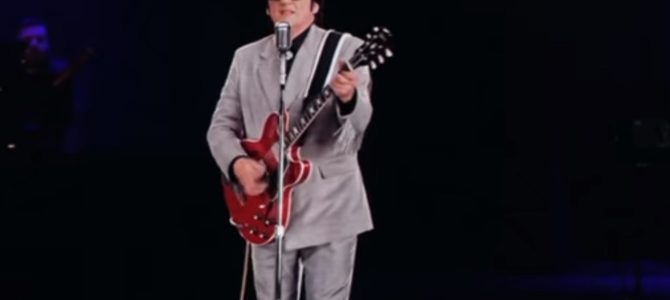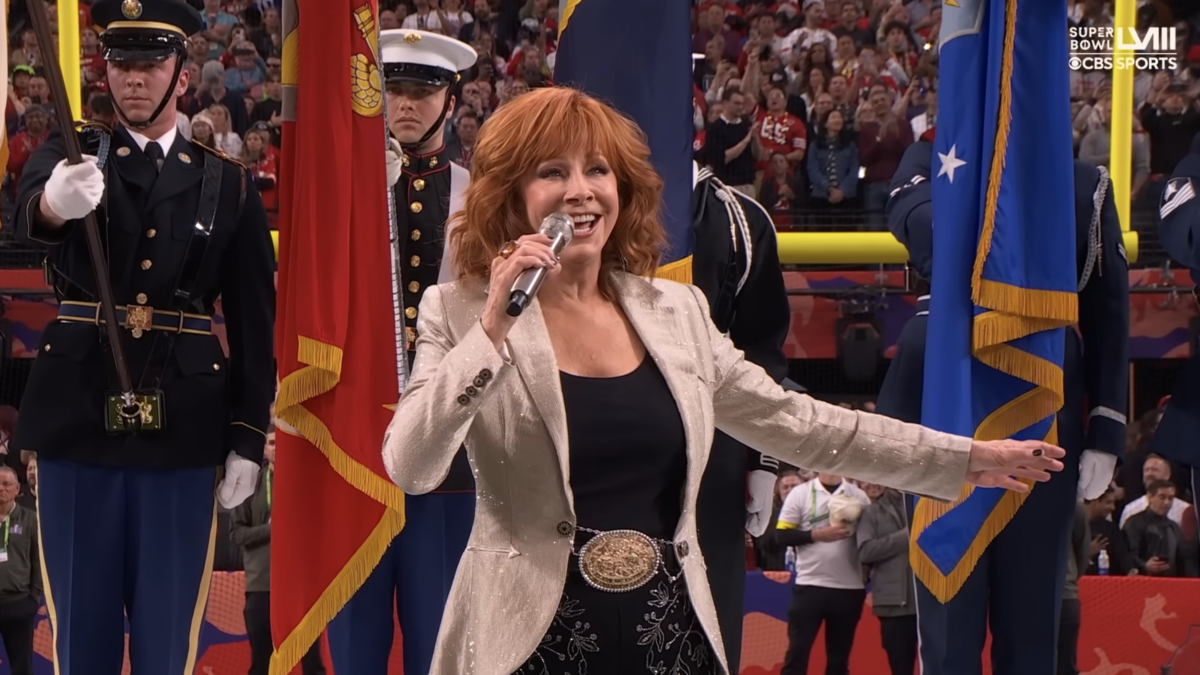
Have you heard that Roy Orbison is touring again? Not in the flesh, of course, but as a hologram. “In Dreams: Roy Orbison in Concert – The Hologram Tour” kicked off last spring in Europe and is currently in the middle of a two-month jaunt across North America.
According to the tour’s website, not only does “Orbison” sing 16 of his timeless, indelible cuts, he also “reacts” to the audience and “interacts” with the orchestra players who perform alongside him. It’s one of those events that’s billed as more than an event. It’s an “experience,” a chance to encounter the past and be a part of the future all in one sitting. Yes, there are more of these experiences on the way.
I’ll admit that I’m more intrigued than put off by the notion of resurrecting dead singers and musicians as holograms. In theory, anyway, I like what the technology has to offer and the possibilities it entails (and there’s the whole idea of concert-going as a form of secular worship, with holograms functioning as sacred iconography, but that’s a different essay for a different day). If you’re a fan of Orbison, here’s a way to experience the beauty of his voice and the magic of his songs in a live setting. I think that’s cool.
You may disagree, but perhaps hearing Orbison’s name in the news has sparked a desire to explore or revisit his music. If that’s the case, let me recommend a convenient way to both see and hear the brilliance of “The Big O”: watch “Black and White Night.”
If the title sounds familiar, it may be because you’ve seen it featured on one of those PBS telethons. Filmed at the since-demolished Ambassador Hotel in Los Angeles in 1987 and first broadcast on Cinemax the following year, “Black and White Night” is as straightforward as it is satisfying. It’s a concert movie that’s all about spotlighting the incomparable, pioneering talent that was Roy Orbison.
There’s no documentary or making-of element to it. It doesn’t show prima donnas butting heads or drugged-out special guests barely able to play their parts. It’s just a live show with a cocktails-and-cigarettes elegance. The only drama comes from Orbison’s brilliant body of songs — “Only the Lonely,” “Blue Bayou,” “In Dreams,” “Oh, Pretty Woman,” and more — which he performs with a “backup” band so loaded with talent and star-power that it feels like a traveling Rock and Roll Hall of Fame showcase.
That’s what immediately jumps out as the opening credits roll. You see the names of all these high-profile musicians who wanted to pay tribute to Orbison. It’s the kind of roster that’s usually assembled for an actual tribute concert, but in this case (as with “Hail! Hail! Rock ‘N’ Roll”) the main act was alive and took part in the show. Included in the band: Bruce Springsteen, Elvis Costello, Tom Waits, Bonnie Raitt, Jackson Browne, James Burton (and three other members of the TCB Band, which backed Elvis Presley from the late ‘60s to his death), T Bone Burnett, Jennifer Warnes, k.d. lang, and more.
It’s obvious throughout how honored everyone was to perform with Orbison. There’s so much warmth and affection in the air. Just watch Raitt, Warnes, and lang as they joyfully pour themselves into their vocal duties on songs like “Dream Baby” and “(All I Can Do is) Dream You.” Or watch Burnett as he gets rowdy on guitar during several songs. Or look at the huge, toothy grin that’s often plastered on the face of Tom Waits. From basically everyone onstage there emanates this mix of joy, gratitude, and a strong desire to honor Orbison with their talents.
Springsteen takes the cake in this department. He’s an open book the whole time, with his facial expressions and physical gestures conveying all of the night’s emotions. He goes from elation to reverence to an almost awestruck disbelief, like he can’t believe his good luck. Honestly, you’ve never seen the Boss quite like this. In the presence of one of his heroes, someone he said he wanted to sing like on “Born to Run,” he’s often reduced to a puddle of boyish glee.
One of my favorite moments comes during “Ooby Dooby” when the guys are trading off guitar solos and it’s Bruce’s turn. Just watch the way he looks over at Orbison and Burton while he’s playing. It’s almost like he’s searching for approval on their faces, like a young boy who wants nothing more than to please his dad. The same is true when he sings harmony with Orbison.
Springsteen has always taken his job as a musician and performer very seriously, but he did so especially that night. Even when he’s away from the action, the camera often captures him having a moment to himself, looking on at the proceedings in quiet, ruminative admiration. Never has the Boss been so happy to play second-fiddle. It might only be slightly hyperbolic to say that was the greatest night of his life.
At the center of it all is Orbison, of course, dressed in black, rocking his signature sunglasses, and hitting those impossible high notes. I think there’s something about watching Orbison perform rather than just hearing him sing that gives you a deeper appreciation for his artistry and why it works. To borrow from Springsteen (who may have lifted the phrase from someone else), Orbison’s specialty was the “romantic apocalypse”– that collision of innocence, love-drunk emotions, heartache, and potential doom.
But on paper, so many of his songs come off as overwrought, feverish, and sometimes just flat-out ridiculous. Very few singers could approach these songs and make them convincing. But the power of Orbison’s heavenly three-octave voice is such that he lends these melodramas real conviction, real emotion, a real beating heart. His voice is just so expressive and heartfelt.
Think of “In Dreams,” maybe Orbison’s finest song and certainly one of the best examples of his unorthodox approach to song structure. The song consists of seven distinct movements. There isn’t a chorus or a bridge or a repeated verse pattern to be found. It just flows and unspools, following the whims of Orbison’s voice.
But recall what the song’s opening lines are: “A candy-colored clown they call the Sandman/Tiptoes to my room every night/Just to sprinkle stardust and to whisper/Go to sleep, everything is all right.” That is too silly for words. It has no business working. It should immediately take you out of the moment. But Orbison’s voice redeems it, and when you watch the performance of “In Dreams” on “Black and White Night,” I think Orbison’s presence plays a role in that too.
He cuts such a gentle, sad, and wounded figure. He’s so old-fashioned, so burger-and-shake. He’s the nerdy kid who either strikes out at the sock hop or can’t even muster the courage to go. All of that imbues the words of his songs with poetic truth.
Or on “The Comedians” (written by Elvis Costello), he literally sings about being abandoned by his girl on a Ferris wheel. Again, it’s achingly precious material, but just watch the “Black and White” performance. It’s mesmerizing. Orbison’s voice and his sad-sap presence combine to transform the lyric, giving it flesh-and-blood. The effect is only heightened by the movie’s gorgeous black-and-white photography and the regular close-up shots of Orbison’s face.
Yet I wouldn’t want to overemphasize the concert’s sad tunes and paint it too much as a funeral march. There was always balance in Orbison’s body of work, something that’s captured to a certain degree in J.D. Souther’s description of Orbison as “the world’s only operatic rockabilly singer.” There’s the desperation and the uplift, the soaring sadness and the high energy. For every downtrodden gem in the show like “Running Scared” (which has a twist ending, I should point out), “Crying,” and “It’s Over,” there’s a shot of life like “Uptown,” “Go Go Go (Down the Line),” and “Mean Woman Blues.”
Of course, the concert closes with “Oh, Pretty Woman,” which gets everyone onstage moving and brings most of the audience out of their seats (an audience that includes the likes of Billy Idol, Kris Kristofferson, Patrick Swayze, and David Lynch, who included “In Dreams” in his 1986 film, “Blue Velvet,” to memorable effect). That’s how it should be. Celebratory, joyful, full of life. Orbison deserved it all.
“Black and White Night” was filmed 14 months before Orbison died of cardiac arrest. It was a humbling triumph for him, one of several key moments in his late-career revival after he had struggled for two decades to make a hit record or be anything but an early-‘60s relic. That same year, he was inducted into the Rock and Roll Hall of Fame (and the Boss introduced him at the ceremony). The following year, he recorded two albums that both eventually became big hits: one with the Traveling Wilburys then his final solo record, “Mystery Girl.” He went on to become the first deceased musician since Elvis with two records in the U.S. Top Five at once.
Orbison left this world far too soon, but he went out on top, and that’s a rarity in show business. He took his final bow feeling affirmed as a professional. That’s one of the strongest impressions that “Black and White Night” leaves with you. Orbison wasn’t just gifted and influential. He was loved and cherished, and his admirers weren’t afraid to show it.









